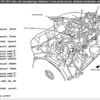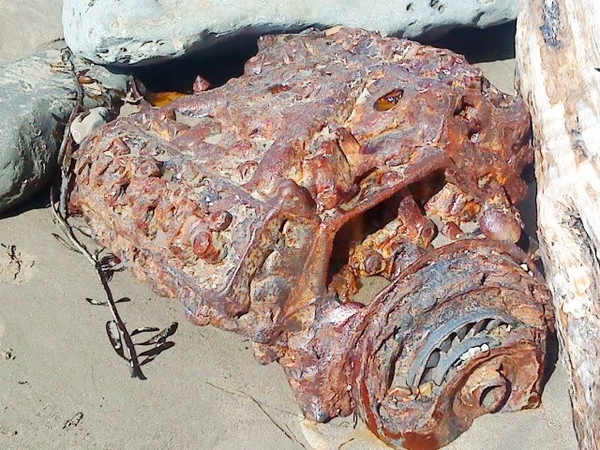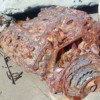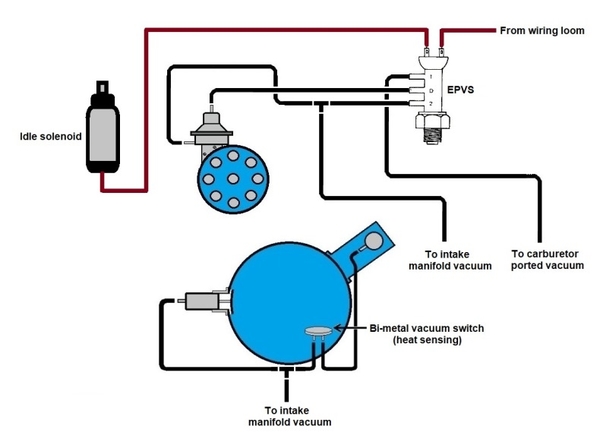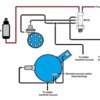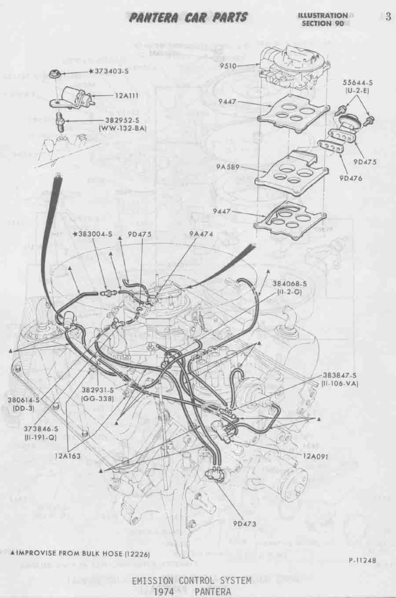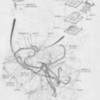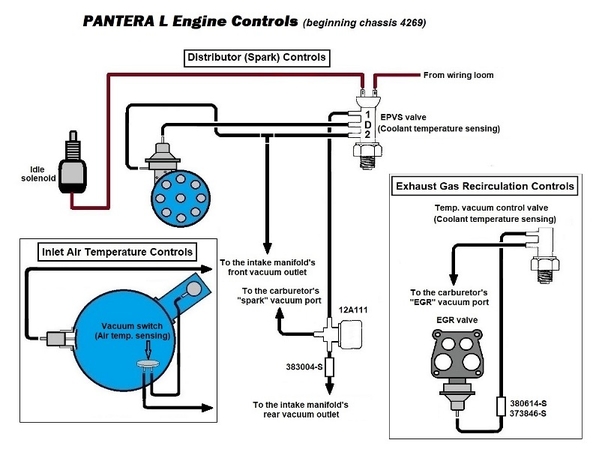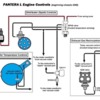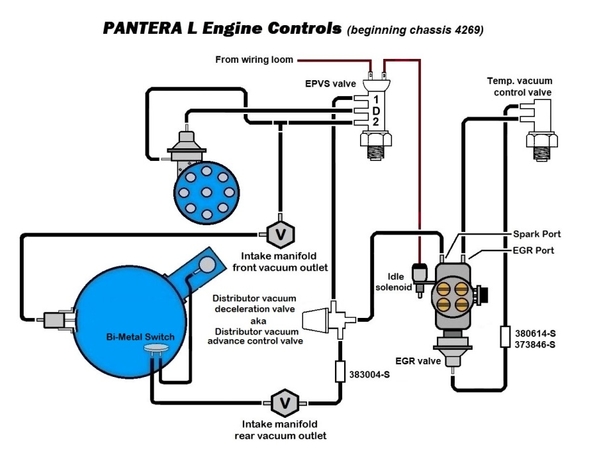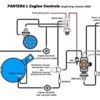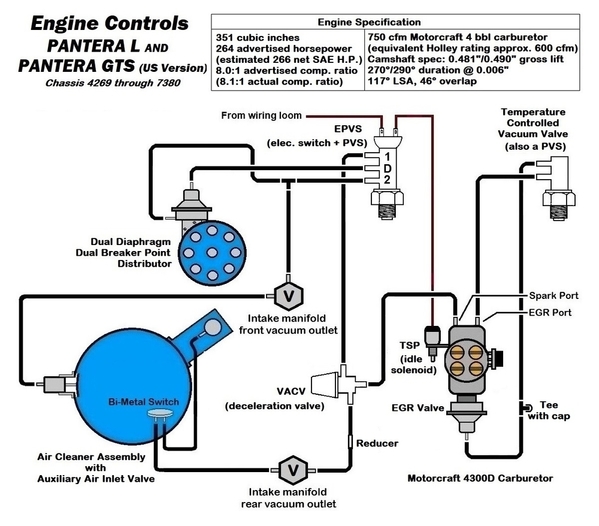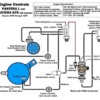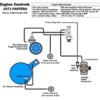I have been tasked to reassemble a 1973 Pantera. The owner wants it to original spec. Does anyone have a diagram for this? The closest I can find is a Boss 429 or Boss 302. They are close (I think) but not correct and don't include the anti overheat plumbing of the Pantera. Any help is greatly appreciated.
Replies sorted oldest to newest
EGR was new in 1973 … older vacuum schematics will not include EGR vacuum plumbing.
My advice is to collect all the necessary components first, test them, make sure they are functional, make sure the diaphragms don't leak, etc. It makes no sense to attempt to make it OEM if ALL of the parts aren't available to do so. I understand some of the emissions equipment is unobtainable. The EGR was still plumbed in my Pantera when I purchased it, but it didn't function properly, it stuck open when it was hot … prevented the engine from idling. New EGR plates for a 4300D carburetor don't grow on trees.
Talking about the 4300D carburetor …. the '73 4300D carburetor knocks engine output down by 90 horsepower. 90 HORSEPOWER!
The overall purpose of the EPVS (anti-over heating controls) was to reduce engine idle speed by 100 rpm upon rising temperature. Coolant pumps are engine driven. Does it make sense to reduce engine speed, and pump less coolant, when an engine over heats? Of course not. The EPVS did more harm than good … not advised making it functional. Replacement coolant tubes have no provision for it either.
The OEM Pantera air cleaner snorkel had a long pleated tube that extended downward to a plastic end piece that scooped air from below the car … make that air, dust, rocks, leaves, candy bar wrappers, debris, etc. Great for sweeping parking lots. It was about as good of an idea as the EPVS.
Ford's normal 4 book workshop manual set was expanded to 6 books in 1973 … there was one whole new book for emissions equipment.
I just went through the Ford 1973 emissions systems manual which has detailed vacuum plumbing diagrams for each iteration of each engine; unfortunately it does not cover the Pantera, and in fact has no listing for any 351C with a manual transmission.
The 1972 picture posted by Ron (Panttera) is the best we got so far.
There is a 1973 listing for a 302 V8 with manual transmission, its a very simplistic control system, seems to represent what controls I remember being in the 1973/1974 engine compartment.
This is what I've got so far Eric
I'll need to take a trip to my public storage unit … I have a box of stuff I removed from my Pantera. Plus I have a 4300D on the shelf. Once I see what all is in there I should be able to document the EGR vacuum controls, fingers crossed.
Might take a couple of days, today is booked.
By the way there is a drawing of a 1974 emissions system (I'm sure its the same as 1973) in the parts book, section 90 illustration 3. Hard to follow. I'm sure you'd prefer a schematic like above.
Attachments
I needed a diversion so I colored the hoses as shown in the Ford Parts Book drawings as best I could.
shown in the parts book, but missing from George's block diagram is the 12A111 ?
the Pantera Ford Parts Book look the same as the routing panttera posted
Attachments
Joe shared his colorized drawing with me last night. With his help I've gotten this far without going to my public storage unit.
Its not finished, there are a few loose ends.
The 3 port vacuum switch, #12A111 in John's picture … its a "vacuum" sensing" 2-way valve. I've drawn it in, but I need to figure out what Ford called it; haven't been able to remember or figure it out yet.
There are 2 other in-line devices: #383004-S and #373846-S. They are probably one way valves (check valves) or perhaps a signal delay. I'd like to figure out their purpose & name too.
Thanks Joe …
Attachments
George,
The Ford parts book calls #12A111 a "Distributor Vacuum Advance Control". It doesn't appear to have any electrical connections.
#373846-S is a tee with a cap on its branch.
#383004-S appears to be a check valve.
John
jb1490 posted:#383004-S appears to be a check valve.
John
I was thinking it might just be a nylon connector to allow changing tubing size, but that is just my guess
jfb05177 posted:jb1490 posted:#383004-S appears to be a check valve.
John
I was thinking it might just be a nylon connector to allow changing tubing size, but that is just my guess
that number pulls up a reducing connector
https://www.npdlink.com/produc...316-inch-x-14/168231
and C8AZ-12A111-A is a Gizmonaut
https://www.ebay.com/p/NOS-Dis...Engine-68/1852506237
it's mentioned in this page
I am overwhelmed by your responses and I thank you all very much. Perhaps I can even add a little. part 383004-S is a reducer-3/16 x 1/4; part 373846-S is indeed a 3 way tee - 3/16 x 3/16 x 3/16 with a cap and that cap is part 380614-S.
I haven't made it to my storage unit. Unless I discover a check valve or delay valve (orifice) at a later date, this is the final product. Thanks to all who assisted, it made the task much much easier. We're a hell of a team.
I have also drawn-up two other similar schematics for 1971 and 1972 Panteras. If anyone who is familiar with those years, or owns a 1971 or 1972 Pantera with intact emissions plumbing, wishes to proof them, please PM me and I'll pass them along.
Attachments
I was pleased that I was able to find just about every part required for a late emission system in my collection of stuff. Missing only the subject item below, the Temperature Controlled Vacuum Valve. I will keep it all together, hope I'll never need it.
I wonder about one thing. Above, George said "The EGR was still plumbed in my Pantera when I purchased it, but it didn't function properly, it stuck open when it was hot … prevented the engine from idling".
Looking at your schematic above, it appears that the 'Temperature Controlled Vacuum Valve' presumably opens when the engine warms up, which then allows engine vacuum to control the EGR valve.
Is the EGR valve simply an open or closed device, or does it feather the valve depending on the strength of engine vacuum? In either case, since idling is a high vacuum situation wouldn't the EGR valve be open at idle when hot?
The rest of the plumbing seems to be primarily related to trying to control idle speed to control overheating and sensing intake air temperature to control the flapper in the snorkel.
The EGR valve is a modulated valve (feathered), via vacuum from the carburetor's "EGR port" which has a distinct difference from intake manifold vacuum because the vacuum signal at the "EGR port" has no vacuum at idle.
Thus there is no EGR at idle … none at wfo either.
Attachments
Does the Spark Port vacuum signal have the same curve as the EGR Port?
To expand on what George mentioned re the air intake and its vacuum lines, the stock air cleaner was clocked in two directions- with the snorkel and choke stove pointed at cylinder #1 for early cars, and for '72-up cars clocked 180 degrees with the snorkel and the choke stove back towards cylinder #8. And remember, Ford cylinder numbers are not the same as for GM and Chrysler products.
larryw posted:Does the Spark Port vacuum signal have the same curve as the EGR Port?
The curves have the same shape, but I can't say if they're identical.
I have successfully plumbed the "spark port" of a Dodge to operate the EGR via a direct connection, the car ran fine and passed the emissions test.
bosswrench posted:To expand on what George mentioned re the air intake and its vacuum lines, the stock air cleaner was clocked in two directions- with the snorkel and choke stove pointed at cylinder #1 for early cars, and for '72-up cars clocked 180 degrees with the snorkel and the choke stove back towards cylinder #8. And remember, Ford cylinder numbers are not the same as for GM and Chrysler products.
As delivered, the snorkel on my early '71 is clocked towards the #8 cylinder.
John



